4- Andinobates opisthomelas :
The Andean Poison Frog
Boulenger, 1899
Additional Photos


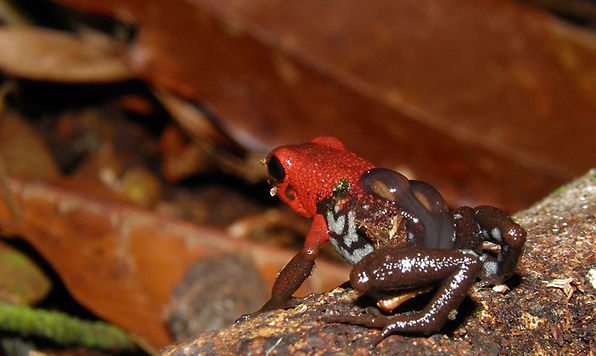


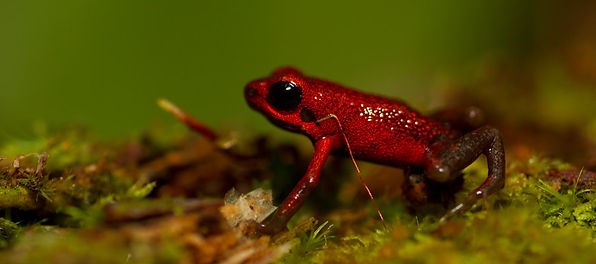
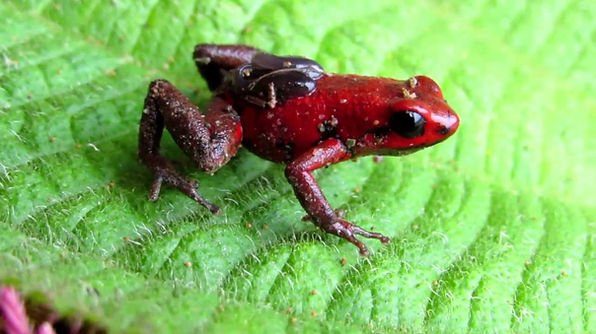

From Wikipedia, the free encyclopedia
The Andean Poison Frog (Andinobates opisthomelas) is a species of frog in the family Dendrobatidae. It is endemic to Colombia. Its natural habitat is subtropical or tropical moist montane forests. It is threatened by habitat loss.
Andean Poison Frog
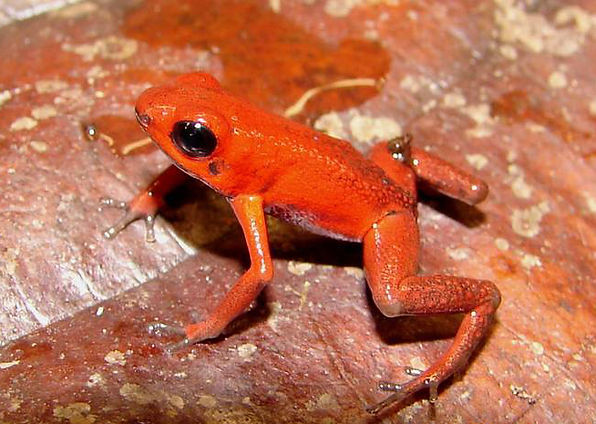

Conservation status
Vulnerable (IUCN 3.1)
Scientific classification
Kingdom:Animalia
Phylum:Chordata
Class:Amphibia
Order:Anura
Family:Dendrobatidae
Genus:Andinobates
Species:A. opisthomelas
Binomial name
Andinobates opisthomelas
(Boulenger, 1899)
Synonyms
Dendrobates opisthomelasBoulenger, 1899
Ranitomeya opisthomelas(Boulenger, 1899)
References:
Ramírez Pinilla, M.P., Osorno-Muñoz, M., Rueda, J.V., Amézquita, A. & Ardila-Robayo, M.C. 2004. Ranitomeya opisthomelas. 2006 IUCN Red List of Threatened Species. Downloaded on 21 July 2007.
Video :
Andean Poison Frog, Andinobates opisthomelas, Colombian Poison Frog, Bosques humedos Yarumal
Care articles :
1- Andinobates opisthomelas (BOULENGER , 1899)
courtesy to : www.dendrobase.de/index.php
Synonyms:
Ranitomeya opisthomelas (GRANT , F ROST , CALDWELL , GAGLIARDO , HADDAD , KOK , MEANS , NOONAN , S CHARGEL & W HEELER , 2006)
Dendrobates opisthomelas ( JUNGFERS , LÖTTERS & J ÖRGENS , 2000)
Minyobates opisthomelas (MYERS , 1987)
Ranitomeya opisthomelas(Anonymous, 1985)
Dendrobates opisthomelas (BOULENGER , 1899)
sensu FROST , 2006
English name: Andean Poison Frog
German name: Andden Baumsteiger
Classification:
Amphibia-> Anura-> Dendrobatoidea-> Dendrobatidae-> Dendrobatinae-> Andinobates -> Andinobates opisthomelas (B OULENGER , 1899)
Group:
sensu G RANT ET AL . (2006)
threat status :
Classified as endangered in the Red List, as the range extends only to an area of 20,000 square kilometers. Clearing and agriculture endanger the occurrence considerably.
size
15-20mm
Habitat:
- Type find location of the first description
"Santa Inés, north of Medellin, Departamento Antioquia, Colombia, elevation 1160 m"
Biotope Dendrobates opisthomelas,
Distribution:
Colombia, northern Cordillera Occidental and central Colombia (Antioquia) up to the eastern foothills of the Cordillera Central in Caldas, 1200-2200m altitude
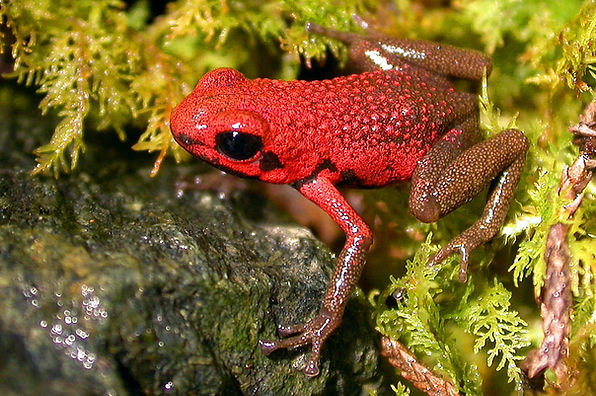

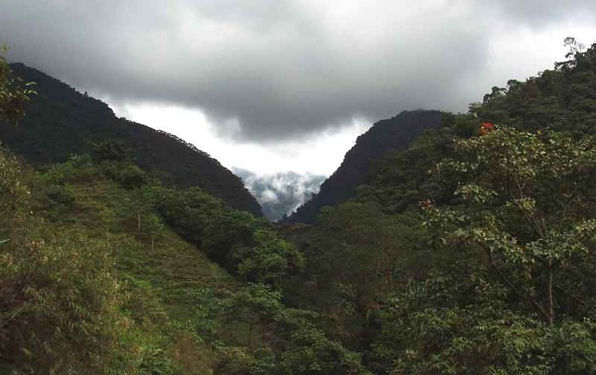


Distribution area Ranitomeya opisthomelas
Biotope:
Mountain rainforests central Colombia,
Attitude in the terrarium :
Terrarium / Facility:
Since this species is not in terrarium, only values of similar sized species can be used here.
Rain forest terrarium from 40x40x40cm
automatic irrigation and fog plant recommended. Keep very moist, but not wet. Avoid waterlogging!
temperatures:
12-22 ° C, drop by 3-4 ° C at night
The rainy season is from March to May and from September to December. Dry periods are from June to August and from December to February.
Annual temperature fluctuation minimal (1-2 ° C)
Humidity:
> 90%, at lunchtime up to 80%, in the morning and in the evening 100% (fog)
Nutrition:
Usual small food animals
Drosophila, micro-crickets, springtails, meadow plankton
Photo:
Ranitomeya opisthomelas
© 2010 Sebastián Vieira
2- Andinobates opisthomelas
Boulenger, 1899
courtesy to : www.dendrobates.org/ andinobates/andinobates-opisthomelas/
Account contributor:
Juan Salvador Mendoza Roldan, Museo de Historia Natural ANDES, Universidad de los Andes, Bogotá, Colombia
For more information about resources for the above article .. click here
Distribution
Endemic to Colombia, distributed along Andean forests in the Northern Cordillera Central and Occidental at altitudes ranging from 720-2640 m. This species has been recorded from the departments of Antioquia, Caldas, Cordoba, and Chocó (Acosta-Galvis et al., 2017). In Antioquia it has been recorded for the Municipalities of Santa Ines, Medellin, Rio Negro, Guatape, Santuario, La Ceja and some municipalities surrounding Paramillo (Silverstone, 1975). Recently, this species has been reported for Anorí, Antioquia (Suarez et al. 2014). The photographed individuals here confirm the species for two new localities, in the Cordillera Central of Antioquia. These observations were made within cloud forests of the municipalities of Carolina del Principe and Don Matias, Antioquia department, at an elevation range of 2000-2200 m.
Natural History
This diurnal species can use a wide array of habitats including degraded and fragmented forests and mature conserved forests. It has never been reported in open grasslands or agro-ecosystems (Rios et al. 2011; Suarez et al. 2014). Silverstone (1975), wrote that all larvae from his study sites were deposited in bromeliads and phytotelmata, and that tadpoles develop in this microhabitat, which could be a reason why the species is negatively affected by the destruction of bromeliads. Extensive habitat destruction, due to cattle grazing and agriculture, has probably reduced its range considerably. A close relation between the presence of healthy populations and pristine forests is noted by the author. Rios et al. (2011) show that the species can use other phytotelmata aside from bromeliads, such as inside the leaf litter, or under fallen logs on the moist forest floor. This species may be abundant in disturbed habitats such as the forests islands at Peñol-Guatapé, Antioquia. Despite the great variation in population density, some populations show a clear relation with the habitat’s structural traits such as bromeliad abundance, percentage of canopy cover, and the presence of a herbaceous understory. Microclimatic variables may explain the presence of the species, and its abundance in forest patches along its geographical range. This species may have densities in forest remnants of Antioquia, ranging from 0.0013 to 0.0173 individuals per square meter. Loaiza-Pidrahita et al. (2016) have shown that populations are mostly composed of reproductively active males, but that this may be caused by a greater detection probability during the dry season. This species is a diet specialist: mites (three different families) and ants were part of the stomach contents found by Silverstone (1975). The population observed from Carolina del Principe inhabited an oak forest at 2100 m. This habitat is characterized by the presence of a dense forest with herbaceous understory, with abundant tank bromeliads (Tillandsia and Vriesia). The frogs were found on the leaf litter in bromeliad bracts. Males were observed during the month of October 2016, carrying 1 to 3 tadpoles on their backs.
Conservation status
Listed as Vulnerable because its Extent of Occurrence is less than 20,000 km2, its distribution is severely fragmented, and there is continuing decline in the extent and quality of its forest habitat in the Colombian Andes (Ramirez-Pinilla et al 2004). This species is known from only one national park (Paramillo), Cordoba department (Romero-Martinez et al, 2008), and from one private reserve “La Forzosa” Anorí, Antioquia (Gutierrez-Cardenas, 2005).
Notes
Thirty different types of alkaloids have been described for the Andinobates bombetes species group; all compounds were assigned to the pumilotoxin A and (hydro) pumiliotoxin C. Secretions from A. opisthomelas have been found to be far more toxic than those from A.bombetes. Iinjection of this toxin into mice causes the loss of locomotor ability after one minute and death of the mouse after eight minutes (Myers et al. 1980).
The call from A. opisthomelas is a buzz sound similar to those produced by all the members of the bombetes group. Male A. opisthomelas are secretive, calling from under the leaf litter, beneath roots of trees, and from inside terrestrial bromeliads.
Tadpoles from this species have two rows of oral papillae, bordering the posterior lip, and are absent from the median one fourth of the posterior lip. Papillae extend to the lateral portions of the anterior lip. The oral disc is laterally indented. Denticle formula (1/3). Beaks are serrate and massive, the lower beak indented. Eyes are dorsal, the spiracle is sinistral and low. The dorsal fin does not reach the body, anus dextral, tail tip rounded (Silverstone, 1975).
Following Amezquita et al. (2013), species in the bombetes group are particularly threatened by intensive agricultural activity within the 1300–2300 m elevation range. Most of them are restricted to disjoint forest fragments surrounded by agriculture. The group currently includes seven species: Andinobates abditus (Myers & Daly 1976), A. bombetes (Myers & Daly 1980), A. daleswansoni (Rueda-Almonacid et al. 2006), A. dorisswansonae (Rueda-Almonacid et al. 2006), A. opisthomelas (Boulenger 1899), A. tolimensis (Bernal et al. 2007) and A. virolinensis(Ruiz-Carranza & Ramírez-Pinilla 1992). Amezquita et al. (2013) describe a species of Andinobates for the municipalities of Andes and Ciudad Bolivar in the department of Antioquia and also for the municipality of Carmen de Atrato, Chocó. This species was described as A. cassidyhornae, and has similar coloration to populations of A. opisthomelasfrom Guatapé. Some records for Antioquia, Colombia, may be assignable to this recently named species (Frost 2016). Andinobates opisthomelas from Guatapé have a unique brown venter, while those from Amalfi show a white venter.
References
Acosta-Galvis, A. R. & D. Cuentas 2017. Lista de los Anfibios de Colombia: Referencia en linea V.07.2017.0 (2 December 2016). Pagina web accesible en http://www.batrachia.com; Batrachia, Villa de Leyva, Boyacá, Colombia.
Amézquita A, R. Marquez, R. Medina, D. Mejia-Vargas, T.R. Kahn , G. Suarez & L. Mazariegos 2013 A new species of Andean poison frog, Andinobates (Anura: Dendrobatidae) from the northwestern Andes of Colombia. Zootaxa 1620: 163-178.
Ríos C., Puerta L., Sierra J. 2011. Densidad poblacional de Ranitomeya opisthomelas y su relación con variables ambientales y de hábitat en cuatro bosques de la Cordillera Central colombiana. Boletín Científico Museo de Historia Natural 15:121–129.
Silverstone P.A. 1975. A revision of the poison-arrow frogs of the genus Dendrobates Wagler. Natural History Museum of Los Angeles County, Science Bulletin, 21, 1–55.
Myers, C.W. & Daly, J. 1980. Taxonomy and ecology of Dendrobates bombetes, a new Andean poison frog with new skin toxins. American Museum Novitates, 2694, 1–23.
Suárez et al. 2014. Guía Ilustrada Anfibios y reptiles Cañón del río Porce, Antioquia. EPM E.S.P. Universidad de Antioquia, Herbario Universidad de Antioquia – Medellín, Colombia. 138 pp.
Martha Patricia Ramírez Pinilla, Mariela Osorno-Muñoz, Jose Vicente Rueda, Adolfo Amézquita, María Cristina Ardila-Robayo. 2004. Andinobates opisthomelas. The IUCN Red List of Threatened Species 2004: http://dx.doi.org/10.2305/IUCN.UK.2004.RLTS.T55195A11256993.en. Downloaded on 20 January 2017.
Frost, Darrel R. 2016. Amphibian Species of the World: an Online Reference. Version 6.0 (2 December 2016). Electronic Database accessible at http://research.amnh.org/herpetology/amphibia/index.html. American Museum of Natural History, New York, USA.
Romero, H. J., C. C. Vidal, J. D. Lynch & P. R. Dueñas. 2008. Estudio preliminar de la fauna Amphibia En el Cerro Murrucucú, Parque Natural Nacional Paramillo y zona amortiguadora, Tierralta, Córdoba, Colombia. Caldasia 30(1):209-229.







Other websites :
- www.gifkikkerportaal.nl/Gifkikkers/andinobates-opisthomelas
- www.dendrobase.de/html/D_andinobates_opisthomelas.html
- www.dendrobates.org/ andinobates/andinobates-opisthomelas/
Videos :
Andinobates opisthomelas
Andean Poison Frog, Andinobates opisthomelas, Colombian Poison Frog, Ranas venenosas de colombia
Ranitomeya opisthomelas (Andean Poison Frog)
Ranitomeya opisthomelas (Andean Poison Frog)
Ranitomeya opisthomelas (Andean Poison Frog)
Madagascar Dart frogs
Aromobatidae :
-
Allobatinae
-
Anomaloglossinae
-
Aromobatinae
South America Dart Frogs - Species
Dendrobatidae :
-
Colostethinae
-
Dendrobatinae
-
Hyloxalinae